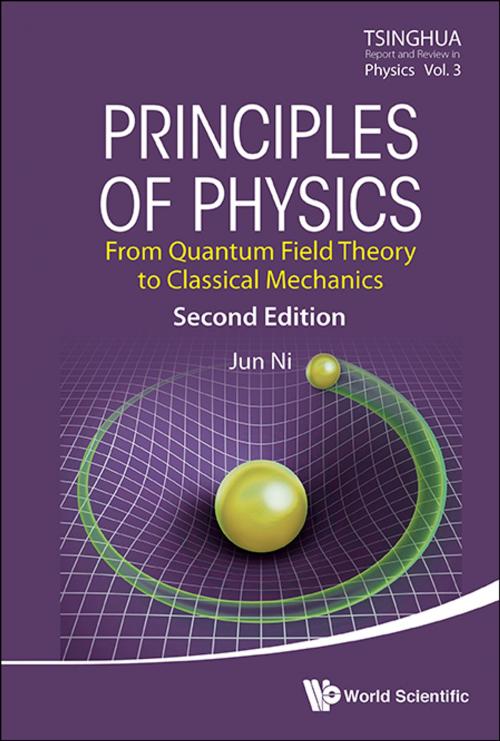Principles of Physics
From Quantum Field Theory to Classical Mechanics
Nonfiction, Science & Nature, Science, Physics, Nuclear Physics, Quantum Theory| Author: | Jun Ni | ISBN: | 9789813227118 |
| Publisher: | World Scientific Publishing Company | Publication: | June 28, 2017 |
| Imprint: | WSPC | Language: | English |
| Author: | Jun Ni |
| ISBN: | 9789813227118 |
| Publisher: | World Scientific Publishing Company |
| Publication: | June 28, 2017 |
| Imprint: | WSPC |
| Language: | English |
This book starts from a set of common basic principles to establish the basic formalisms of all disciplines of fundamental physics, including quantum field theory, quantum mechanics, statistical mechanics, thermodynamics, general relativity, electromagnetism, and classical mechanics. Instead of the traditional pedagogic way, the author arranges the subjects and formalisms in a logical order, i.e. all the formulas are derived from the formulas before them. The formalisms are also kept self-contained. Most mathematical tools are given in the appendices. Although this book covers all the disciplines of fundamental physics, it contains only a single volume because the contents are kept concise and treated as an integrated entity, which is consistent with the motto that simplicity is beauty, unification is beauty, and thus physics is beauty.
This can be used as an advanced textbook for graduate students. It is also suitable for physicists who wish to have an overview of fundamental physics.
Contents:
-
Preface
-
Preface to the Second Edition
-
Basic Principles
-
Quantum Fields
-
Quantum Fields in the Riemann Spacetime
-
Symmetry Breaking
-
Interacting Quantum Fields
-
From Quantum Field Theory to Quantum Mechanics
-
Electromagnetic Field
-
Quantum Mechanics
-
Applications of Quantum Mechanics
-
Statistical Mechanics
-
Applications of Statistical Mechanics
-
Relativity Theory
-
Appendices:
- Tensors
- Functional Formula
- Gaussian Integrals
- Grassmann Algebra
- Euclidean Representation
- Some Useful Formulas
- Jacobian
- Geodesic Equation
- Bibliography
- Index
Readership: This is suitable for graduate students and physicists who wish to have an overview of fundamental physics.
Key Features:
- Establish the formalisms of all disciplines of fundamental physics from a set of common basic principles in a unified way
- The formalisms are self-contained. All physical formulas appeared in this book are derived from the formulas before them
- The basic principles are made simple and the elucidations are concise
This book starts from a set of common basic principles to establish the basic formalisms of all disciplines of fundamental physics, including quantum field theory, quantum mechanics, statistical mechanics, thermodynamics, general relativity, electromagnetism, and classical mechanics. Instead of the traditional pedagogic way, the author arranges the subjects and formalisms in a logical order, i.e. all the formulas are derived from the formulas before them. The formalisms are also kept self-contained. Most mathematical tools are given in the appendices. Although this book covers all the disciplines of fundamental physics, it contains only a single volume because the contents are kept concise and treated as an integrated entity, which is consistent with the motto that simplicity is beauty, unification is beauty, and thus physics is beauty.
This can be used as an advanced textbook for graduate students. It is also suitable for physicists who wish to have an overview of fundamental physics.
Contents:
-
Preface
-
Preface to the Second Edition
-
Basic Principles
-
Quantum Fields
-
Quantum Fields in the Riemann Spacetime
-
Symmetry Breaking
-
Interacting Quantum Fields
-
From Quantum Field Theory to Quantum Mechanics
-
Electromagnetic Field
-
Quantum Mechanics
-
Applications of Quantum Mechanics
-
Statistical Mechanics
-
Applications of Statistical Mechanics
-
Relativity Theory
-
Appendices:
- Tensors
- Functional Formula
- Gaussian Integrals
- Grassmann Algebra
- Euclidean Representation
- Some Useful Formulas
- Jacobian
- Geodesic Equation
- Bibliography
- Index
Readership: This is suitable for graduate students and physicists who wish to have an overview of fundamental physics.
Key Features:
- Establish the formalisms of all disciplines of fundamental physics from a set of common basic principles in a unified way
- The formalisms are self-contained. All physical formulas appeared in this book are derived from the formulas before them
- The basic principles are made simple and the elucidations are concise















